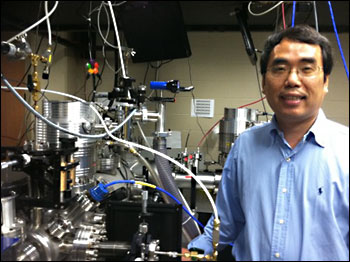
Record Laser Pulse the Key to Hidden Quantum World
ORLANDO, Fla., Sept. 4, 2012 — The most significant breakthrough in the laser pulse field in four years provides scientists with a new tool to watch quantum mechanics in action — a world hidden from view until now. The work was also accomplished without using specialized equipment, such as a mile-long particle accelerator or Superdome-sized synchrotron.

Zenghu Chang and colleagues at the University of Central Florida generated the shortest laser pulse to date — 67 attoseconds — without using specialized equipment such as a particle accelerator or synchrotron. The work gives scientists a new tool for watching quantum mechanics in action. (Photo: UCF)
University of Central Florida professor Zenghu Chang of the department of physics and CREOL | the College of Optics and Photonics led the effort that generated the shortest laser pulse to date — a 67-attosecond (1 attosecond is a quintillionth of a second) pulse of extreme-ultraviolet light. Chang’s group created a technique called double optical gating (DOG), which allows extreme-ultraviolet light to be cut off in a manner that concentrates the maximum amount of energy in the shortest possible pulse of light.
Besides creating the light pulse, he created an even faster camera to measure it, which works using a process called phase retrieval by omega oscillation filtering (PROOF).
There is much excitement about the accomplishment and the promise that Chang's work holds for helping scientists understand how the world's smallest building blocks actually work. The technique could lead them to an understanding of how energy can be harnessed to transport data, deliver targeted cancer therapies or diagnose disease.
"Dr. Chang's success in making ever-shorter light pulses helps open a new door to a previously hidden world, where we can watch electrons move in atoms and molecules and follow chemical reactions as they take place," said physicist Michael Johnson, the dean of the UCF College of Sciences. "It is astounding to imagine that we may now be able to watch quantum mechanics in process."
Attosecond pulses were first demonstrated in 2001. Since then, scientists worldwide have been trying to make ever-shorter pulse durations because of the information they could provide in understanding the subatomic world. The previous record of an 80-attosecond pulse was set in 2008 at Max Planck Institute in Garching, Germany (see Light Pulse Speed Record Set). This is the first time an American-led team has set the record.
The US Department of Defense’s Multidisciplinary University Research Initiative and the National Science Foundation helped fund the research.
The results are published online under Early Posting in the journal Optics Letters.
For more information, visit: www.ucf.edu
Published: September 2012